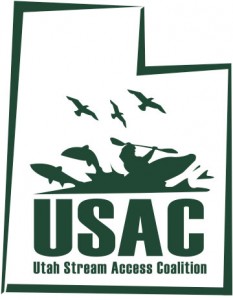 From USAC:
From USAC:
USAC’S POSITION ON ANGLER ACCESS TO THE LOWER PROVO RIVER
Have you been confused about whether you are permitted to fish on the Lower Provo River? You are not alone. The Lower Provo currently sits in a legal gray area: If it is designated or adjudicated as navigable, there would be no question that you are permitted to recreate on the beds and banks of the river so long as you enter it from a lawful access point. But it hasn’t been deemed navigable and none of the relevant state agencies appear to be interested in settling this uncertainty.
The Utah Stream Access Coalition (USAC) has provided ample evidence to the State of Utah demonstrating commercial use of the Provo River prior to statehood which would support it being deemed navigable. If you are familiar with USAC’s legal success on the Upper Weber River, the same legal theory argued in that case–navigability being determined by a showing of commercial use of the river at statehood–is equally applicable on the Provo River. Moreover, the State has had this evidence for almost six years, and a financial appropriation was passed approximately five years ago to create a river analyst position, who was, in part, tasked with reviewing the evidence and making recommendations based upon it.
Due to this continued uncertainty, USAC has outlined its position on the issue below.
BACKGROUND:
Historically, the Lower Provo River, running from from Deer Creek Dam to the mouth of Provo Canyon has been open to the public for fishing, boating and other recreational activities. Although some of the lands along the river are privately owned, there has never been a question about the public’s right to use the river itself. Recently, however, certain landowners along the upper reaches of Provo Canyon have begun harassing anglers who are legally fishing in the river. These landowners claim the river is not public, and that fishing is not allowed where the river flows past their properties. State and local law enforcement authorities have not recognized the landowners’ claims to the river, and, as far as USAC knows, no angler has been charged with trespass for being in the water. Nevertheless, the harassment continues.
USAC’S POSITION:
1. Under the precedent established on the Upper Weber River in Utah Stream Access Coalition v. Orange Street Development, 2017 UT 82, the Provo River is a navigable water based upon its historical use for commerce. The general public are entitled to use the beds of navigable waters – up to the ordinary high-water mark – for lawful recreational purposes.
2. Consequently, there is no basis for pressing trespass charges against persons lawfully using the Provo River and its bed and banks below the ordinary high-water mark.
3. The public right to use navigable waters does NOT include the right to cross adjacent dry lands if those lands are not publicly owned or subject to an easement or public right-of-way. The crossing of such dry lands without permission from the landowner constitutes an act of trespass. USAC has always opposed such acts of unlawful trespass.
ACCESS TO THE RIVER FROM PUBLIC ROADWAYS & PARKING AREAS
The Utah Department of Transportation owns numerous parcels of land adjacent to the Lower Provo River, as well as rights-of-way extending from public highways and the Heber Valley Historic Railroad (i.e., “Heber Creeper”) line, that allow lawful public access to the river from existing public parking lots through access corridors. However, not all of these public access corridors are well marked and some are being contested by adjacent landowners. None of this, however, affects the rights of the public once they are in the river.
RECOMMENDATION:
If you are troubled by the current situation on the Lower Provo, USAC encourages you to direct your concerns to the Utah Division of Wildlife Resources, who are tasked with enforcement of wildlife related access and trespass laws. Call 801-538-4700 and ask for the Wildlife Resources Director’s Office. To quell the current campaign of harassment by Provo Canyon landowners, USAC has met with officials from Utah’s Department of Natural Resources in an effort to secure an official declaration that the Lower Provo River is navigable and therefore there is no basis to issue trespass citations to persons lawfully using the river and its bed below the ordinary high-water mark. Our last communication is attached here. State officials have neither acknowledged receipt of this letter, nor followed through on our request to issue a declaration of the public’s rights on the Lower Provo River. It is disappointing to say the least that illicit attempts to privatize treasured public resources are met with silence from responsible public officials.
WHAT CAN YOU DO?
As outlined above, unless the Lower Provo River is designated navigable, public access to it will remain unclear. Because its is evident that the State of Utah will not do so, adjudicating this case in the courts remains the only other option. To do so, USAC needs to put together a case with appropriate circumstances to support litigation. For now, USAC is actively seeking tips and information through “confrontation reports” submitted on the Coalition’s website in order to be able to a file a navigability lawsuit on the Provo River. With your assistance, USAC may be able to force this issue sooner rather than later.
As always, we appreciate your continued support!
Board of Directors
Utah Stream Access Coalition




1 Comment
Doesn’t the Utah Constitution guarantee public access to waterways by way of the “public trust doctrine”? To me it’s like public streets/highways….do the landowners along streets have the right to deny access to the streets just because they own land on either side or both sides of the street? Rivers and lakes have long been considered public thoroughfares, just like streets and highways and should never be privatized. I like the old definition of navigable waterways as “any water body that can float a canoe or a log during normal high water” and “foot access up to the normal high water mark, with access around natural or manmade barriers”.